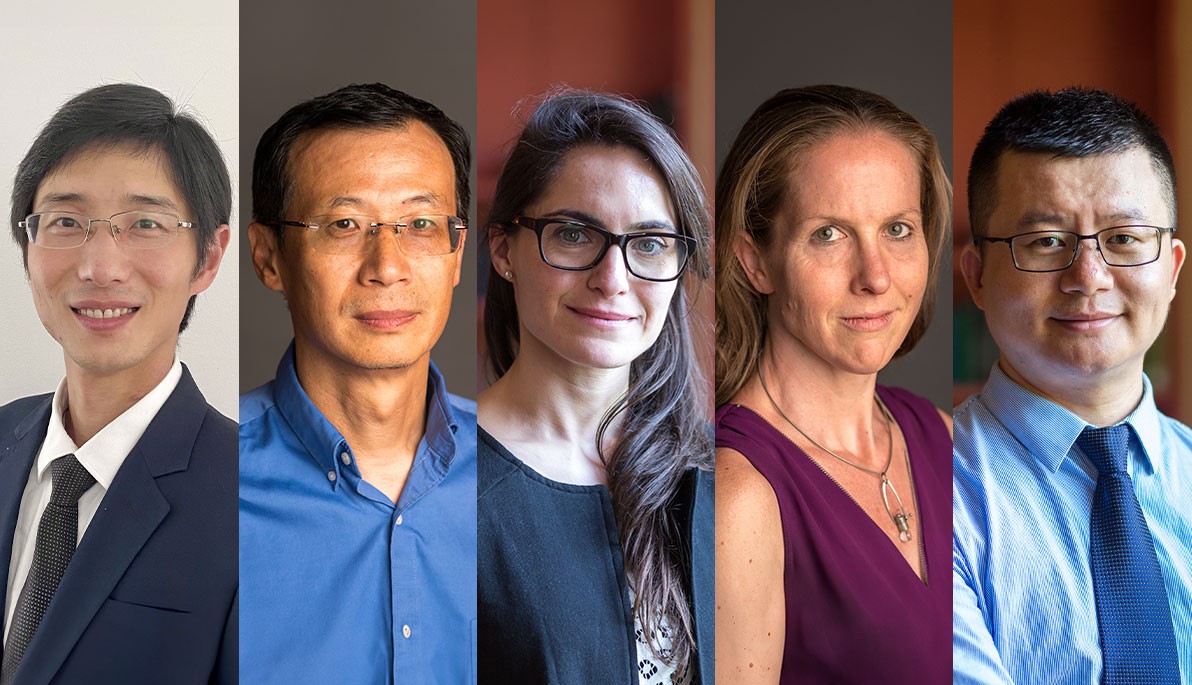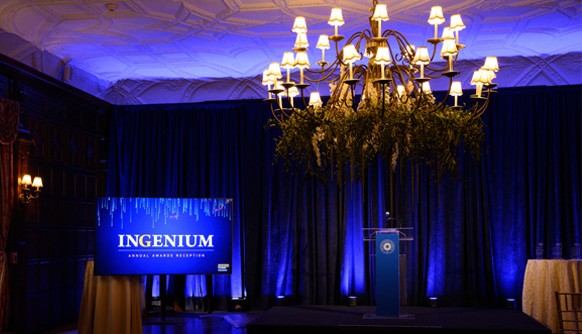News
Researchers Secure Prestigious Federal Grants
October 2, 2023
Pictured from left: Weikang Cai, Jerry Cheng, Sophia Domokos, Eve Armstrong, and Yusui Chen
In recent weeks, five research projects led by New York Tech faculty have collectively secured more than $1.6 million in federal funding from the National Science Foundation (NSF) and the National Institutes of Health (NIH).
The funding will support projects spanning physics, computer science, and biomedical science, captained by faculty from the College of Arts and Sciences, College of Osteopathic Medicine (NYITCOM), and College of Engineering and Computing Sciences. Findings from these studies could help to advance quantum computing, lead to new Alzheimer’s disease treatments, explain how heavy elements first formed, enable mobile devices to detect cardiovascular disease, and offer insight that could revolutionize magnetic resonance imaging (MRI) and magnetic levitation (maglev) technologies.
The research projects will also engage undergraduate, graduate, and medical students, providing excellent opportunities for them to gain a deeper understanding of the scientific process and mentorship from some of the university’s brightest minds.
Advancing Physics Understanding by Quantum Leaps
A research team led by Assistant Professor of Physics Yusui Chen, Ph.D., has secured an NSF grant totaling $650,0001 for a three-year project that could enhance understanding of quantum physics within real environments—a necessary step to advancing the field of quantum computing.
Many scientists and experts believe that quantum computing could provide the necessary insight to help solve some of society’s biggest issues, including climate change and deadly diseases. However, much remains unknown about how these systems operate, and uncovering their full potential first requires an advanced understanding of the physics principles that provide their theoretical framework.
Quantum computers, which are made of information storage units called qubits, are inherently subject to environmental influences. Some multi-qubit systems are influenced by a memory of past interactions with the environment, thereby affecting their future behavior (non-Markovian systems). However, few mathematical tools exist to study these dynamics, and as systems grow larger and more complex, modeling them on classic, binary computers is unfeasible.
Chen and his research team—which includes undergraduate and graduate physics, computer science, and engineering students, as well as a researcher from Rutgers University—will establish a comprehensive method to investigate these dynamics while improving the accuracy of existing quantum simulation algorithms. Their insights could deepen understanding of the fundamental physics in which quantum computers operate.
The project also includes efforts to build a pipeline of diverse talent and researchers, a critical factor in helping to advance the field of quantum information science and engineering (QISE). As such, Chen will mentor undergraduate New York Tech students, particularly female students and those from traditionally underrepresented backgrounds. He will also conduct outreach to K–12 schools with the aim of introducing STEM concepts and sparking younger students’ interest in QISE.
Solving the Mystery of How Heavy Elements Formed
A project led by Assistant Professor of Physics Eve Armstrong, Ph.D., has received a three-year NSF grant totaling $360,0002 in support of her continued research into one of science’s greatest mysteries: how the universe formed from stardust.
The research will build on Armstrong’s earlier NSF-funded project, which received a two-year $299,998 NSF EAGER grant in 2021.
While the big bang created the first and lightest elements (hydrogen and helium), the next and heavier elements (up to iron on the periodic table) formed later inside ancient, massive stars. When these stars exploded, their matter catapulted into space, seeding that space with elements. Eventually, their stardust matter formed the sun and planets, and over billions of years, Earth’s matter coalesced into the first life forms. However, the origins of elements heavier than iron, like gold and copper, remain unknown. While they may have formed during a supernova explosion, current computational techniques render it difficult to comprehensively study the physics of these events. In addition, supernovae are rare, occurring about once every 50 years, and the only existing data is from the last explosion in 1987.
Armstrong posits that a weather prediction technique called data assimilation may enhance understanding of these events. The technique relies on limited information to sequentially estimate weather changes over time, which may make it conducive to modeling supernovae conditions. With simulated data, in preparation for the next supernova event, Armstrong and undergraduate New York Tech students will use data assimilation to predict whether the supernova environment could have given rise to some heavy elements. If successful, these “forecasts” may allow scientists to determine which elements formed from supernova stardust.
Since receiving her EAGER grant in 2021, Armstrong and her students have begun using the technique for the first time with real data from the sun’s neutrinos (tiny, nearly massless particles that travel at near light speeds). This is an important test to assess the technique’s performance with real data, which is significantly more challenging than simulation. Their most recent paper, published in the journal Physical Review D, is promising.
Armstrong’s NSF-funded project will also support her broader impacts work on science communication. Since 2021, she has led workshops for young scientists at New York Tech and the American Museum of Natural History, where participants use techniques from standup comedy, storytelling, and improvisation to create original performances. In addition, for the first time, Armstrong is teaching a formal course on improvisation for New York Tech students this semester.
Improving Alzheimer’s Disease Understanding
Assistant Professor of Biomedical Sciences Weikang Cai, Ph.D., has received a $306,000 NIH grant3 to lead a two-year research project that will investigate how certain molecules may play a role in the progression of Alzheimer’s disease.
Adenosine triphosphate (ATP) is a small molecule within cells that fuels nearly all biochemical and cellular processes in living organisms. Under specific scenarios, both neurons and non-neuronal cells in the brain can release ATP outside of cells. Consequently, ATP can serve as a signaling molecule to communicate with nearby brain cells and regulate their functions. In addition, growing evidence demonstrates that astrocytes, the most abundant non-neuronal cells in the brain, may contribute to the development of Alzheimer’s disease.
Using a mouse model, the researchers will assess how ATP released from astrocytes is regulated with Alzheimer’s disease and whether eliminating astrocyte-released ATP could alter disease progression. Their findings may lead to the development of new strategies to treat or alleviate Alzheimer’s disease and its related symptoms.
Other members of the research team include Biomedical Sciences Instructor Qian Huang, Ph.D., and Senior Research Associate Hiu Ham Lee, M.S., who initially spearheaded the project, as well as NYITCOM students Zoya Ramzan, Lucy Yu, David Shi, Alexandra Abrams, Sky Lee, and Yash Patel, and undergraduate Life Sciences students Addison Li and Priyal Gajera. In addition, several other NYITCOM students contributed to preliminary studies leading up to the current project, including Marisa Wong, Shan Jin, Min Seong Kim, and Matthew Jiang.
In 2021, Cai also received an NIH grant to research how chronic stress inhibits ATP release, thereby reducing dopamine activity and potentially contributing to clinical depression.
Preparing Mobile Devices to Detect Cardiovascular Disease
Assistant Professor of Computer Science Jerry Cheng, Ph.D., has received an NSF grant totaling $159,9794 for a three-year project to establish a data analytics and machine learning (artificial intelligence) framework that could allow at-home mobile devices like smartphones to detect biomarkers for early symptoms of cardiovascular disease.
Mobile devices usually have restrictions in memory, computing power, and battery capacity for complex computations. To address this, Cheng and his research team will develop software deep learning accelerators, which will allow mobile devices to perform AI modeling. They will also develop security measures to mitigate attacks on cloud systems (computationally efficient trusted execution environment), as well as time-dependent models to analyze sensing data, such as respiratory rate, blood pressure, heart rate, etc. Graduate and undergraduate students from the College of Engineering and Computing Sciences will be recruited to assist in the project, which will also focus on promoting female engineering student participation.
Cheng has secured multiple NSF awards since arriving at New York Tech in 2019. In 2021, he received funding for mobile edge research to help ensure that smart device computing advancements do not outpace experiments in the field; in 2020, he received an award to design more efficient and secure deep learning processing machines that can reliably process and interpret extremely large-scale sets of data with little delay.
Shedding Light on the Inner Workings of Matter
Associate Professor of Physics Sophia Domokos, Ph.D., has secured an NSF grant totaling $135,0005 for a three-year research project to explore the inner workings of matter. Domokos seeks to uncover how tiny elementary particles (quarks and gluons) interact to create new orders, like clumping together to form protons and neutrons in an atom’s nucleus.
While scientists have a relatively useful mathematical explanation regarding how these tiny elementary particles behave, these models do not account for particles interacting frequently and forcefully. To address this, Domokos and her research team will use holographic duality, a string theory concept, and a mathematical structure called supersymmetry to categorize and classify the clumps of elementary particles that emerge in strongly interacting systems.
The insights they gain could shed light on the inner workings of protons and neutrons, as well as other strongly coupled systems such as high-temperature superconductors, special materials that could revolutionize key technologies like MRIs and maglev trains.
Domokos has recruited undergraduate students to assist in her previous NSF grant-funded research and will continue to do so for this latest study. Students will gain a deeper understanding of theoretical physics, as well as skills like solving differential equations and using scientific computation software, and firsthand experience drafting physics research papers.
Footnotes:
1This project is funded by NSF Award ID No. 2328948 and will be completed in partnership with researcher Hang Liu, Ph.D., of Rutgers University. The content is solely the responsibility of the authors and does not necessarily represent the official views of the NSF.
2This project is funded by NSF Award No. ID 2310066 and will be completed in partnership with University of Wisconsin–Madison physicist Akif Baha Balantekin, Ph.D. The content is solely the responsibility of the authors and does not necessarily represent the official views of the NSF.
3This grant was supported by the National Institute on Aging of the National Institutes of Health under Award Number 1R03AG083363. The content is solely the responsibility of the authors and does not necessarily represent the official views of the NIH.
4This project is funded by NSF Award No. ID 2311598. The content is solely the responsibility of the authors and does not necessarily represent the official views of the NSF.
5This project is funded by NSF Award No. ID 2310305. The content is solely the responsibility of the authors and does not necessarily represent the official views of the NSF.



_Thumb.jpg)

